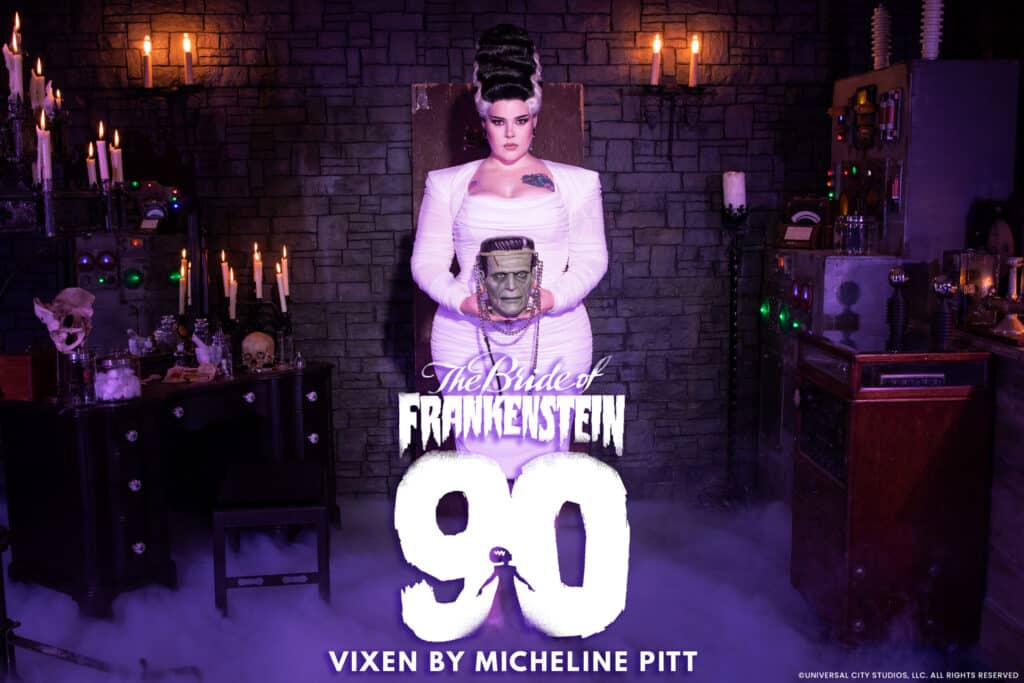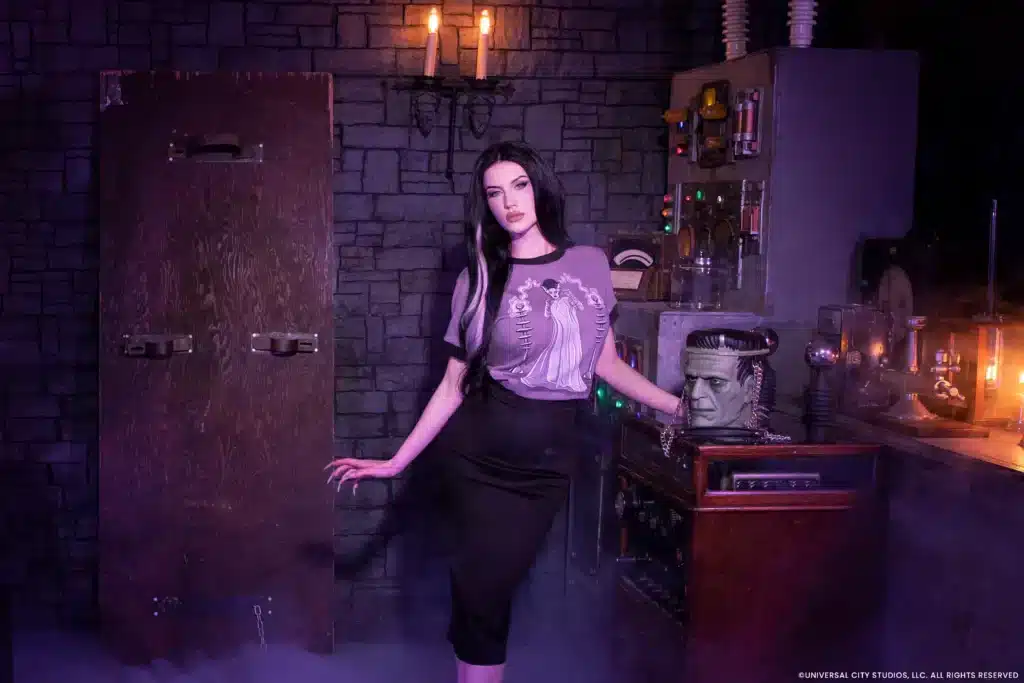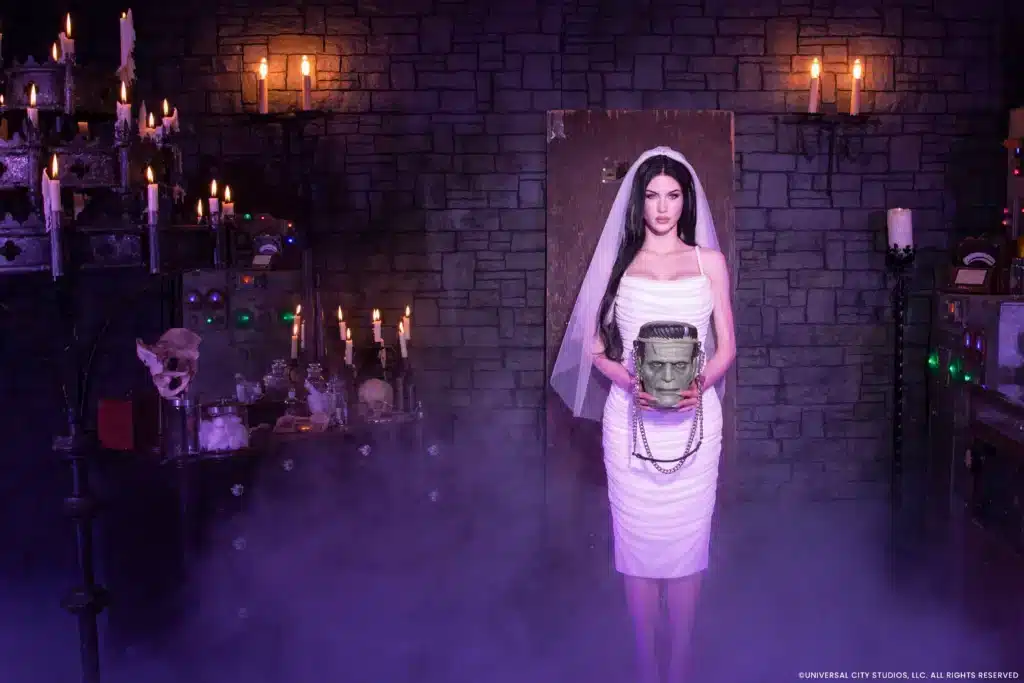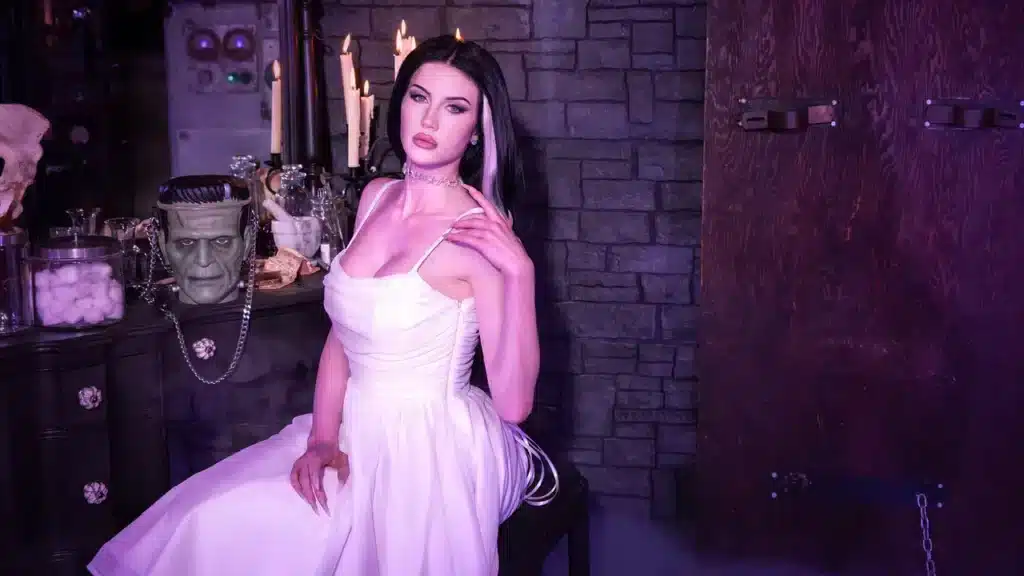By RICKY J. DUARTE
Within the dark pantheon of iconic cinematic monsters, none capture the curiosity, imagination and hearts of audiences quite like The Bride. Bound in gauze, stitched together at the seams and sporting an electrifying quasi-beehive, it would have been easy for filmmakers to have portrayed The Bride as ghastly and hideous—perhaps, even, prompting her monstrous mate’s infamous line, “We belong dead,” to be more easily digestible to audiences of the era. Yet, in bestowing her with a salient silhouette, a curious elegance and, most importantly, a powerful countenance, audiences were struck with instant adoration for the monstrous matron. Her bearing on popular culture has continued to reign over the 90 years since her revelation to the world.
Continuing the theme of women possessing powerful countenance, artist, filmmaker, designer and general multi-hyphenate artistic virtuoso Micheline Pitt has unleashed upon the world her newest line of fiendish fashions from her clothing brand, VIXEN. Following the success of her Creature from the Black Lagoon line, her official collaboration with Universal Studios continues, this time taking inspiration from The Bride of Frankenstein.
Including wiggle and swing dresses (with matching bolero jacket) inspired by The Bride’s nuptial bandage gown, jewelry befitting any hardcore hardware lover and a bag worth losing your head over, Pitt’s designs reflect an enduring taste both magnificent and macabre, proving that “Timeless terror deserves timeless style.” If anyone is an appropriate choice to take on this monstrous task, it’s Micheline Pitt.
Amidst the approach of her writing and directorial contribution to the upcoming anthology film sequel V/H/S/Halloween(with husband and creative partner R.H. Norman—stay tuned), Pitt took a moment with RUE MORGUE to discuss the new capsule collection, her creative process and the significance of The Bride, not only to popular horror culture, but to herself.
How did you come to collaborate with Universal?
It’s so funny, because I’m also a writer and director in film, I had a general meeting with the head of Universal Monsters at the Universal Office. Her name’s Holly Goline, and she’s amazing. We just hit it off and she saw that I was also a fashion designer. We started talking about how she had wanted a very specific collaboration for Creature for the 70th anniversary and how she thought it should include the swimsuit, etc. A lot of the collaborations that they tend to do aren’t as specific to creating these kinds of pieces. I started showing her the stuff I’ve done with other studio collaborations, and that’s just kind of what kicked off my relationship—it was actually someone from the film side of monsters putting me in touch with the consumer product scene at Universal and fostering that relationship forward.
What does The Bride mean to you, specifically?
Well, I think if you talk to anyone that identifies as a woman, The Bride is kind of our only real monster, especially when we’re talking about classic Universal Monsters. She’s the most iconic. When you look for anything that could be identified as a male-specific character, there’re so many options. There really aren’t a lot for women. So, I think as young people, when we grow up watching these movies, it’s hard to not see yourself in these characters. “Oh, that’s a girl. I’m a girl.” And initially it all starts with that. For me it did, and I think it does for a lot of other people.
I feel like my relationship with Bride has progressed and evolved as I’ve progressed and evolved as an individual and my relationship with what being a woman is and what it’s like to be alive in the world that we live in. I see and relate to her in so many different, deeper ways now as an adult than I did when I was a kid. I think that as an adult, she is an icon for female rage as much as Carrie is. We can relate to a lot of female characters in horror and adjacent to rage.
A big experience of being a woman is that it’s hard to not have that internalized rage because we’ve always kind of been othered, as far as never being in the same position as men are when it comes to our life experiences. If you look at our rights and what we’ve been able to do and our autonomy, especially when this film was made, women didn’t have the autonomy. Women couldn’t have careers and jobs. They couldn’t have bank accounts. They couldn’t have credit cards. They couldn’t run a business. There were so many things that we weren’t allowed to do. And to think a woman is just created to be an object for this other thing and person and that’s her whole existence … I think it’s sad that she’s only in a movie for five minutes, but I feel like she resonates from so many deeply personal levels of what womanhood is and what women’s lives are like in some ways that I feel like people associate and resonate with her character on such a deep, emotional and philosophical level beyond it just being a horror character.
As you mentioned, Elsa Lanchester’s iconic performance is only on screen for roughly four or five minutes. What is it about this sequence that has made it so effective and lasting?
It’s really frustrating when we say that, right? The Bride of Frankenstein—the movie’s named after her and she’s literally in it for five minutes. But if there’s ever an example of what it’s like to be a woman in the film industry, there’s a perfect example.
It’s strange because I think The Bride would not be as popular as she is had her design and her regalness—her stature, her presence, the hair, the makeup, the wardrobe choices—not been so specific. I do not think that she would be as important as she is now. I think that a lot of her story that isn’t being able to be told throughout the film because she’s there for such a small amount of time is made up for through her presence and through the design choices of her character. They’re so substantial and unique and unlike anything anyone had seen before, much like Frankenstein’s presence in that first film. I think that she has that same vulnerability, but it’s also really beautiful … but powerful.
I’ve always wondered what’s the story behind that scream. I really hope that Universal at some point will give space for that story to exist and explore what her character has meant for fans of her character. I think that there’s a lot that we’ve put from our own experiences into her character and I think there’s a lot to explore.
That Bride film has been in talks for years and keeps getting pushed back. But if ever there were a time, it’s now—we need it.
My biggest hope is that there’s women involved. I don’t feel that you can do that in a vortex. The Bride of Frankenstein is the way it is because of the reflection of the time, and I hope whenever it does happen that there are women involved on upper levels of its development.
Let’s move into your new line. Describe the process of drawing the connection between costume and wearable fashion attire.
There are always limitations to what I can do because of price points. My customers aren’t going to be able to buy a five- or six-hundred-dollar dress. So as much as I wanna go all out at times as a designer, I have to be realistic while also trying to achieve the detail and the design that I want. With this (Bride) dress, specifically, it’s probably one of the most constructed and complex pieces I’ve made for my brand. The entire bodice is like a full corset and then it has all these grommets and corset lacing down the back. It’s all functional to a point because there is a panel that is sewn in so that your entire backside isn’t just out. I’ve worn something that’s not like this many years ago and it had a modesty panel that was not sewn in, and I didn’t even know my underwear were showing all night!
That was something I definitely didn’t want customers experiencing—having a wardrobe malfunction. I wanted the dress and the bolero specifically to feel like bandages while also feeling like a really feminine fashion piece. The shoulder pads on the bolero are so much more severe than anything I’ve ever done. It’s very “Alexander McQueen” when I think about the shape but it’s also very much Bride of Frankenstein when you look at her shoulder shape and that silhouette.
It’s an absolutely beautiful line and it speaks to a very specific kind of alt subculture of people. When you’re designing, who is your ideal wearer of these lines that are based on icons of the horror genre?
I think with anything that we love and we’re fans of, that you have to realize that we are all types of people. My customers are all genders, all shapes and all cultures. I don’t have any specific type of person that I envision. It’s whoever is putting on something that I make, but it makes them love themselves more and feel amazing. That’s always my only goal, is for someone to be able to get something and put it on and be like, “I look amazing! I feel amazing!” There’s power in that and I just want people to feel powerful or beautiful when they put something on that I design or make, no matter who they are.
Your designs magnify the importance of body type inclusivity. How does this awareness feed into your creative process?
It’s strange that we even have to have conversations about being inclusive as artists and designers. And I think that’s just a reflection of our experience as young people in high school, even. Fashion brands have made a choice for a long time to purposely make people feel unwelcome.
That should be the point of conversation. Rather than celebrating myself or any other designers that are inclusive, we should be putting a flashlight on the people that are making people feel like they’re not wanted. I think it’s a responsibility as a designer to try as much as we can. I’m a very small brand that’s privately owned, but it’s really shocking that huge, hundred-and-twenty, two-hundred-million-plus businesses are making a choice to not welcome those people in their clothing. I think that those are the same people that would have bullied all of us in school.
It’s a big reflection of our society, not progressing and becoming better. That’s sad, truly. And that’s how I honestly feel as a designer. I think it really speaks to who a person is, and a business is, if they refuse to make other people feel welcome.
What parallels do you find between horror and fashion?
It’s storytelling. That’s the same thing I do as a writer, director and also as a fashion designer. I’m telling a story. I build worlds when I do photoshoots, when I style something in a specific way, when I pick a specific color or cut or person to wear something—I’m telling a story.
As designers, we’re constantly telling stories, and my interest in genre and horror reflects what the human experience is. To be alive; to experience the world around us. That is very much who I am. I tend to go a little darker and a little bit more melancholy. I’m in a position of having complex emotions because that’s just a part of the experience of the world around us. I also see its beauty. And I think there’s a lot of beautiful things in the horror genre. I try to meld these two conflicting worlds constantly with anything I make, where something can be hyper feminine and beautiful, but at the same time, there’s something underneath it all that is powerful.
When you pull from multiple time periods like I do, it’s easy for people to be like, “Oh, this is very traditional clothing,” or “Is this trad-adjacent?” It’s like, no, it’s really about the fact that there are certain silhouettes and shapes and styles that aren’t being offered that are incredibly flattering and powerful on the human body that I think should still exist. And it has nothing to do with getting stuck in a place in time. When you look at these old films, there’s so much design and detail and thoughtfulness put into everything that you don’t often see now in films. It’s easy to look at those things and get inspired.
Detail and thoughtfulness are apparent in all your lines. That level of craft must come from the many talents you have. When it comes to designing clothing, how do you chip away to what works best and what will be the most versatile in wear? How do you center and focus on achieving this gorgeous power as a running theme throughout all of your pieces?
Well, I wear everything. I try everything on while we’re developing it. And I am neurodivergent, so I have a lot of sensitivities to fabric textures. I try my best to be like, “If I can wear this, I’m hoping other people can.” And if I can put something on and I’m like, “This feels disgusting, I need this off my body immediately,” then I know there’s a problem. It’s either the fabric or the fit or there’s something else happening. I try to make things beautiful, but also wearable because as our bodies change and develop, we need more structure, support and flexibility. So having adjustable straps, having fabrics that have stretch, or having dresses that have some smocking or at least backs that can be adjustable. Having giant pockets! As a woman, it’s nearly impossible to buy clothing that actually has real pockets. I remember once, I tried on a pair of jeans and it had a pocket seam in the front, but when I went to go stick my hand on it, it was a fake pocket. They put in all of that work to make it look like it had a pocket, and it didn’t. I just thought like, “This is a joke.” Why can’t clothes universally have the same functions, but then have them be tailored to our aesthetics?
My brand is very high-fem presenting, but we have a lot of customers that are all different genders and types of people. Because of our size range and our flexibility of fit, a lot of different body types can wear our clothes that necessarily can’t do that with a lot of other brands. We try to make our clothing as flexible as possible. We also build shape into our clothes, so if you laid one of our dresses or items on the ground, you would actually see the shape of a human body in that garment. A lot of things (today) are made to be loose-fitting or just straight, and no one is shaped like that after a certain age.
The thoughtfulness of our design is realizing that people with bodies are actual bodies, and clothes should be made to fit them. Now, will my clothes fit every type of body? I’m sure there’s going to be certain people that our fit might not work for, but the people that it does work for have very few places to shop, and I’m happy to fill that gap for them.
I appreciate how gender-inclusive the line is. I’m about to preorder this Stitches Choker. It’s absolutely very much “me!”
I was really surprised at how popular it was because I don’t make a whole lot of jewelry. It definitely made me want to make more. When I designed the dress, I wanted a piece of jewelry that feels Bride of Frankenstein-coded, but it’s, like … nice, and isn’t a Halloween costume piece. So that’s kind of how that happened.
Is there a piece from this line that you’re most fond and proud of?
My Frankenstein’s Monster bag. I was the first person to ever make three-dimensional bags with that detail and design and paint and color. The Frankenstein’s Monster was the first (bag) I knew I wanted to do, but we had started with our deal doing Creature as our initial collection, so I was really hoping that I’d get an opportunity to make that bag and I’m so happy I did.
It was such an exciting thing to be able to draw and sculpt and design something that is three-dimensional like that that people can wear and stick on a shelf or carry with them. It’s really cool to be able to innovate a piece of fashion in a way that melds my interest in collecting toys, figurines and collectibles into fashion.
He’s beautiful! I appreciate that it zips across the forehead. Is there another Universal Monster you’d like to design a line based on?
All the monsters have something interesting. I definitely feel like Dracula is something I’ve got some unique fresh ideas for. I know that all of my Wolfman girly-friends want me to do something—probably a bag. There are definitely more bag ideas, and there’s more extension into accessories. I’m working on this concept for next year for bags that no one’s done yet and hopefully will get it out in time before someone else does it first. It would encompass all the monsters, which would be really cool.
I’m hoping to continue our relationship with Universal for many more years to come. They’re truly my favorite to work with. I love their consumer products team, their marketing team and their creative team. They really love these characters, and they’ve allowed me to make things no one else has done and it’s been very encouraging and collaborative. They’re the best folks. I’ve worked with every movie studio, and I can say hands down that Universal has been my favorite.
One last bonus question. It’s a bit to do with what we were speaking about earlier—The Bride’s representation in the film. James Whale was famously an openly gay man and there have been many queer reads into his work, especially this movie. Do you think Whale’s queer sensibility seeps into the design and showcase of The Bride in her sequence?
You can really tell when men love women because they’ll design and make things that make them look amazing. You can see, even though her character has such a sad story, he made her look powerful and beautiful. So, I would say that that’s a reflection of him as an artist, to make those choices to put beauty in a place where it’s darkest.
Having him as a filmmaker behind those initial Frankenstein films really helped, because you can’t look at horror and not see how queer-coded it is for so many people. And, also, for just being othered, because, let’s be honest, that is the core part of any monster story. I feel like that is what the queer experience is. I feel like that’s reflective of that.
It would have been so interesting to see more films from him beyond horror, but we went from having queer films when filmmaking began to them controlling everything and censoring everything. That’s unfortunate because it would have been really interesting to see what else he would have done as a filmmaker. It speaks to how strong a person he was, to be out and openly queer at that time.







